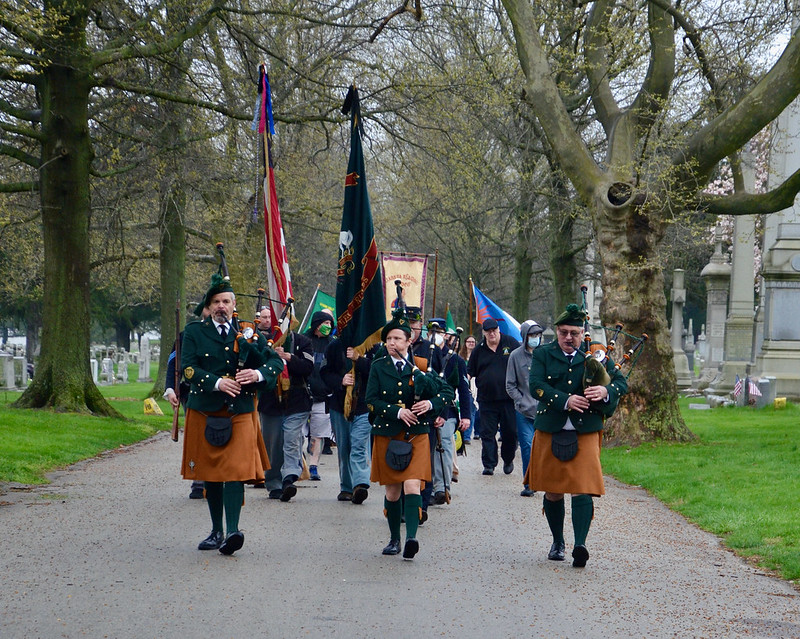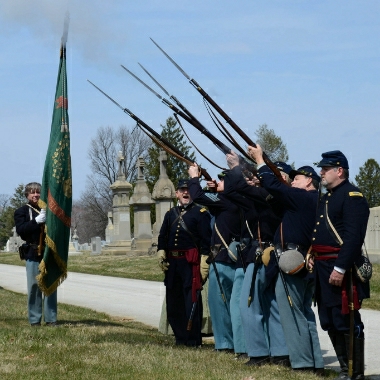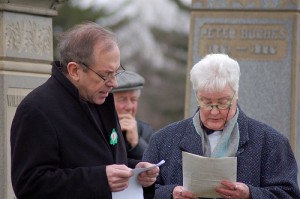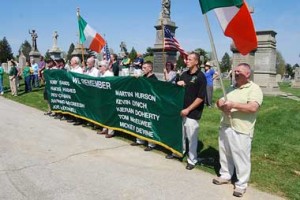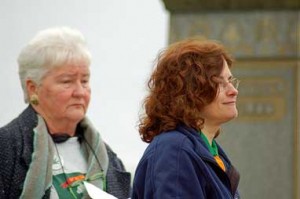
Patricia Bonner and Patty Loomer.
The Easter Rising ended—after one bloody, tumultuous week—more than 90 years ago. The heroes of the failed insurrection are long dead. Ireland is a prosperous republic, a leader on the world stage, thanks to their vision and sacrifice. (Thanks, too, to the disastrous miscalculation on the part of the British government in turning those courageous but flawed human beings into martyrs.)
Northern Ireland, the scene of so much heartache for much of the 20th century, is not without its troubles—but now, perhaps, with a small “t.” Still, Ulster appears to be “set for a new course,” as Northern Ireland Deputy First Minister Martin McGuinness put it in a recent visit to the White House with First Minister Ian Paisley.
A casual observer of history might wonder, then, why so many people—members of Irish Northern Aid, Clan na Gael, the Ancient Order of Hibernians—are still bothering to commemorate that abortive, long-ago rising.
We’re standing at the Holy Cross Cemetery gravesite of Joe McGarrity, the one-time Philadelphia wine and spirits merchant, leader of Clan na Gael, and one of the one of the world’s great physical-force republicans. McGarrity, who came to the U.S. from County Tyrone in 1892, died in 1940. And still, here we are in this sprawling Delaware County burial ground, and we’re listening to Tom Conaghan, executive director of the Irish Cultural & Heritage House of Pennsylvania, read from the Proclamation of Independence, crafted by Padraig Pearse, leader of the 1916 rising. The words of that brief address, read out by Pearse himself from the steps of the Dublin GPO, still hold tremendous power:
Irishmen And Irishwomen: In the name of God and of the dead generations from which she receives her old tradition of nationhood, Ireland, through us, summons her children to her flag and strikes for her freedom.
So, why? Why dredge up that abortive, long-ago rising and all those troubled dead generations, now that Martin McGuinness and Ian Paisley are singing “Kumbaya” at the White House?
Patty Loomer, a member of most of the organizations toting banners on that cool, drizzly Sunday afternoon, offered a few remarks during the ceremony. With her interest in history, organizer Pat Bonner tapped her to review the life of Joe McGarrity. This was her third time. To her, one big reason to march every year to Joe McGarrity’s final resting place is the man himself.
“He borrowed money to get the ship to New York,” she recalls. “He had to borrow maney from a guy on the ship so he could get from New York to his aunt’s house in Philadelphia. Whatever he did, he was very determined.”
The other reason is simple remembrance of Pearse and all the others who took such monumental risks for Ireland. Loomer says: “It’s a commemoration. It’s a reminder of all the people who sacrificed so much.”
We have photos from the day.

